Indications are that the DMK combine will win more seats than the AIADMK and BJP, but is facing a tough fight in about half a dozen from the rest, predicts N Sathiya Moorthy of the electoral contest in Tamil Nadu.
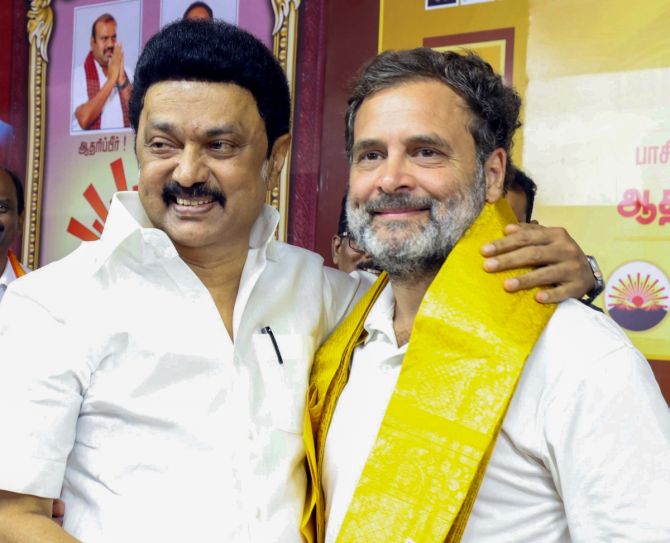
The curtain has rung down on the campaign scene in Tamil Nadu and the state cast its lot in the first of seven-phase polling on Friday, April 19.
In the reckoning are 40 Lok Sabha seats, including one from the Union Territory of Puducherry, where too people speak Tamil but do not always take their electoral cue from larger Tamil Nadu, especially in the assembly polls.
It is even more curious to note that barring rare occasions, it’s winner-takes-all kind of a situation in the state in Lok Sabha polls for over 55 years, but with near-singular exception under the ‘Modi spell’ elsewhere.
Tamil Nadu voted one-sided in 2014 (AIADMK, 37/39) and 2019 (DMK-Congress combine 38/39) but that did not have any national impact, as in the past decades.
The BJP-NDA sweep elsewhere almost across the nation meant that the Modi government at the Centre did not require Tamil MPs’ support for survival, as Atal Bihari Vajpayee and Manmohan Singh did as prime ministers — or, was it under the ‘mercy’ of the TN partner in the ruling alliance at the Centre, as was often being made out?
Poll Schedule Works Against First Phase Contestants
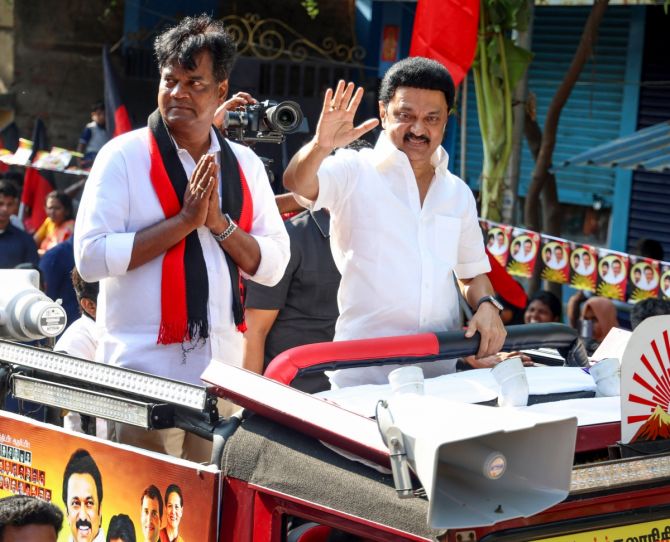
This time round after a long gap, the state is facing a true three-cornered contest, with the ruling DMK-led alliance that includes the Congress, two Communist parties and the Muslim League intact.
This has led to the common belief that the DMK alliance is sitting pretty at the top, though not as comfortable as the massive victory margins from 2019 should indicate.
There is a fourth element, which the national media has ignored. Actor-politician Seeman’s pan-Tamil Naam Tamizhar Katchi (NTK), which alone has the courage to field candidates for all 40 seats.
The Election Commission’s last-minute denial of the party’s earlier common symbol of ‘Sugarcane Farmer’ symbol did ruffle the leadership, yes, but they are in business as always, even during the interregnum between two elections.
As coincidence would have it, the NTK’s new symbol, ‘Mike’, symbolises the man.
Seeman is almost always portrayed in front of a microphone, delivering one of his fiery speeches that go beyond north India’s traditional understanding of a pan-Tamil/Dravidian leader.
While continuing to swear by Sri Lanka’s slain LTTE leader Velupillai Prabhakaran, he asks how Narendra Modi offered worship only at Srirangam, Rameswaram and Tirupati — and not in any of the temples of Lord Murugan (Tiruchendur and Palani) and Lord Siva in Madurai, which (alone) are considered ‘Tamil gods and temples’ (though of common Hindu heritage).
Going by past elections and present pollsters’ predictions, the NKT is no write-off in terms of vote share even while continuing to not win a single seat, this time too. But with the predicted 8 to 10 per cent vote-share, the party can become the deciding factor in closely fought constituencies, even where the DMK combine is said to be maintaining an edge.
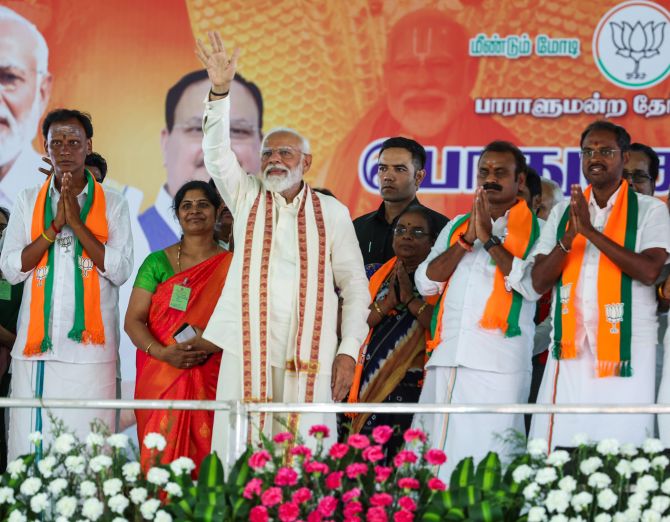
It’s elections for the Lok Sabha, but traditionally it has also been a referendum on the ruling party in the state — barring in 2014, when then AIADMK chief minister Jayalalithaa’s ‘Modi-ya, indha Lady-ya?’ campaign won the day.
However, Modi and the BJP, rather deliberately turned the heat on themselves by the prime minister’s frequent campaign visits to the state in the past year, especially the past couple of months.
If that happened this time, then it would have been an unprecedented record against the Dravidian stranglehold, which it is not going to be.
However, en route, the party became somewhat pragmatic by playing for the second spot and pushing the one-time AIADMK ally to the third slot, when Modi took over from state BJP chief K Annamalai’s ‘DMK Files’ kind of attacks on the ruling party but failed to deliver the ‘punches’.
The reasons are not far to seek. The gap between the BJP’s understanding of the state and the ground realities is what is ruling the elections, this time, too.
The state came to terms with political corruption and dynastic politics very long ago but Modi in particular continued to whip a dead-horse.
Though the DMK or even the new-found AIADMK rival, was/is in no position to target the BJP, in turn, on graft, the Supreme Court judgment on Electoral Bonds did it for them.
Then, there are the BJP allies in this election in Tamil Nadu, against whom corruption charges or issues of financial irregularities have been hanging over their heads from three decades downwards, with the Modi government doing nothing about it.
The list includes PMK’s former Union minister Anbumani Ramadoss, whose wife is the NDA candidate in Dharmapuri, and T T V Dhinakaran (Theni) whom central agencies got jailed in Tihar, for seeking to influence the Election Commission on the AIADMK symbol issue, not to forget the Lexus car-import case from the nineties.
Thrown out from the AIADMK, OPS is now an ‘Independent’ ally of the BJP, contesting the Ramanathapuram seat on ‘Jackfruit’, a free symbol.
Likewise, the star-couple Sarath Kumar and Raadhika are still facing a GST fraud case involving a total payment close to Rs 8 crore (Rs 80 million), where imminent arrest is the norm.
They merged their nondescript party with the BJP and Raadhika Sarathkumar is now the BJP candidate from Virudunagar, in the South.
Among the BJP’s other candidates are educational entrepreneurs S Pachchamuthu alias Parivendhar of the SRM Group (in Perambalur, against DMK minister strongman K N Nehru’s son Arun Nehru), A C Shanmugam (Vellore) and Devanathan Yadav (Sivaganga), who all own letter-head parties and are contesting on the ‘Lotus’ symbol — if only to boost the party’s vote-share, if not seat-share.
As if this were not enough, the BJP candidate and party assembly group leader, Nainar Nagendran, is now caught in a ‘poll code violation case’, after three of his aides, including a relative, were allegedly nabbed with Rs 3.98 crores (Rs 39,8 million) in cash, confessed to have been meant for election expenses, from a running-train.
Modi added a twist to the tale by visiting the state for one last time, to campaign for Nainar in his southern Tirunelveli constituency.
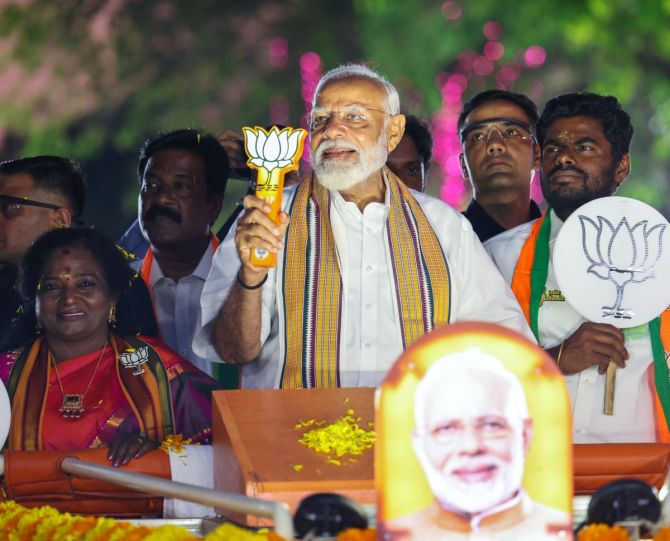
As coincidence would have it, the BJP’s efforts to continue embarrassing the Congress rival at the national level by talking constantly about DMK Minister Udhayanidhi Stalin’s comments on Sanatana Dharma only whipped up dormant anti-Brahminical sentiments outside the Dravidian political-fold.
It is different from the BJP’s perceptions of the DMK’s so-called anti-Hindu, anti-god sentiments which, if at all, were in the distant past.
It used to make good politics but never was a decisive electoral issue — as became the case with the Sri Lankan ethnic issue in later days.
If the BJP relied on the social media campaigns against the late DMK patriarch and chief minister M Karunanidhi and his ideological guru, Periyar E V Ramaswamy Naicker, in 2019 and 2021, this time round, Modi and a host of BJP leaders from the national level, most of them senior Union ministers, managed to choose non-issues in their anti-DMK, anti-Congress (or, was it the other way round?) campaigns in Tamil Nadu.
Once again, their campaign fell flat. At the top of the list is the Katchchatheevu controversy, which Modi harped on for long until possibly advised about the multiple negative fall-outs in neighbouring Sri Lanka.
It’s old wine in an old bottle for the Tamil voters, and the Rameswaram fishers themselves do not consider it a holy cow, whose retrieval would solve all their fishing problems in and with Sri Lanka and the nation’s Tamil fishers.
Already, some (motivated?) social media posts have claimed how by unnecessarily referring to a non-issue that his government did not touch for ten long years and which it cannot take to international fora, if required, Modi has deflected away from the real problems facing Rameswaram and other Indian fishers in Sri Lankan waters.
Distracters were quick to point out how the BJP’s manifesto, published much later, did not refer to the Katchatheevu issue at all, leave alone talking about its retrieval.
Of course, Tamil is the only language, by which the BJP swore by in the manifesto for global promotion through Thiruvalluvar centres, but it does not seem to have cut much ice because the Tamil voters ‘have seen through it all’, as again social media critics were not tired of claiming.
Otherwise, too, there is not one project or programme that Modi offered to the state during his multiple campaign visits, nor was there any response to the charges against his government on price-rise and unemployment, these critics alleged. Again, there was no convincing response.
It is the kind of very wrong advice that Modi seemed to have got in 2019 from his Tamil Nadu advisors.
Addressing a rally in western Coimbatore, he did not touch upon the GST issue which was a burning problem for the local industry, starting with the SME sector that dots the horizon.
Instead, he was talking about Pulwama and the surgical strikes.
The BJP candidate, C P Radhakrishnan, a two-time victor, lost by 179,00 vote margin, that too in the company of the AIADMK, whose stronghold Coimbatore and the rest of the western region were/are.
He was soon declared ‘retired hurt’ and made the governor of Jharkhand state, with the gubernatorial assignments in distant Telangana and Puducherry added for effort after incumbent Tamizhisai Soundararajan quit, to contest the Tamil Nadu polls as the BJP candidate in the prestigious Chennai South constituency.

In contrast, this elections has shown up Stalin as a serious and purposeful campaigner, who began by changing the BJP’s Sanatana Dharma narrative by launching a fusillade against the Centre’s ‘step-motherly’ treatment of the state, especially in matters of fiscal devolution that went against the Constitution’s federal principles — which in turn translated as ‘maanila suyatchi‘, or ‘self-rule in states’ in the DMK’s diction.
However, by giving instant and mostly convincing responses to Modi and Finance Minister Nirmala Sitharaman, in matters of central funding and usage, has created positive vibes.
This is one up on his 2019-2021 imagery as a ‘new generation’ (?) leader who wanted to change the way Dravidian politics was being perceived, within the state and outside.
In this Stalin is backed by Modi not visiting the two flood-hit areas of Chennai and Thoothukudi in December and the BJP’s inability of Sitharaman rushing all kinds of aid and assistance, particularly to the latter (with an eye on the constituency at the time?) even in those early hours.
At the same time, the Stalin government’s ‘freebies’ scheme for women may not be as much of a vote-catcher as presumed earlier.
The list includes free bus-travel for all women, Rs 1,000 per month for women-headed families and the flagship scheme of free breakfast for primary school children aimed at bringing back Covid era school dropouts and ensuring better enrolment.
There is also the 1,000-rupee per month for college-going girls, since extended to boys from poor families.
That is because of the negativity that has come to attach to his regime, owing mainly to the corruption charges targeting senior ministerial colleagues.
They have also been abrasive in public, unconscious of the possibilities in the era of social media, and also a general perception of lawlessness and cadre-highhandedness attaching to every DMK regime since the early Karunanidhi days from the late sixties.
That leaves the AIADMK behind. Coming from behind in the rat-race between the other two main contenders, party boss and former chief minister Edappadi K Palaniswami (EPS) is going all-out to make it a three-cornered contest.
Having understood the BJP gameplan rather late, he is out to push the party into a distant third slot, having set his sights only on the 2026 assembly polls and his own ambitions for returning as CM.
If only he had woken up to the reality a li’l early, EPS may have convinced his top-notch leaders to contest themselves, instead of settling for second and third-liners, some of whom are new to the constituency, if not to electoral politics, as happened to the DMK rival in 2001.
Now, the indications are that EPS may succeed in many, if not all constituencies, which neither of them is able to win against the DMK combine.
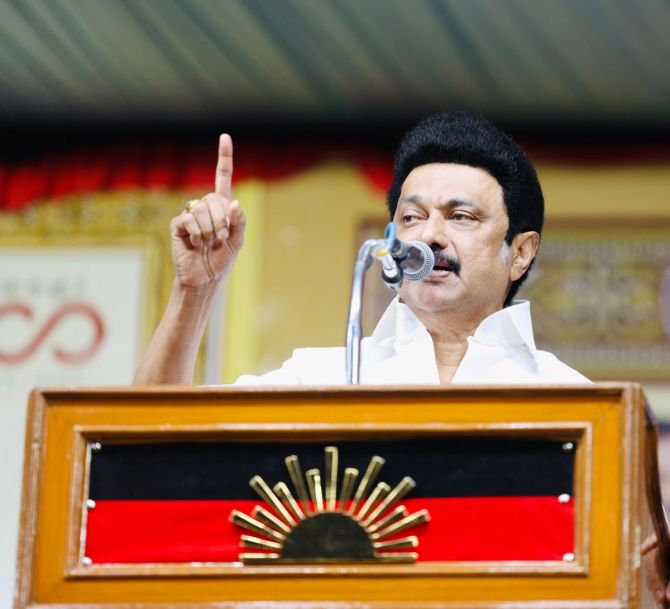
Where is it all headed on polling day? The DMK and the AIADMK have committed cadres with vast experience in poll-day management.
It is lacking in many constituencies for the BJP-NDA, barring possibly Kanyakumari and Tirunvelveli — the former because of a stronger cadre-base and the latter because of the expertise that candidate Nainar Nagendran has in the department.
Elsewhere in the last two elections, 2019 and 2021, the AIADMK and PMK allies had taken over the BJP’s responsibilities but only the PMK has returned to the BJP-NDA combine this time, after a break.
Yet, the BJP and PMK do not share any shared stronghold other than western Dharmapuri, where Sowmya Anbumani, as the alliance candidate, is a strong candidate.
So are BJP nominees like state unit chief Annamalai in Coimbatore, L Murugan (Nilgris) and Tamizhisai Soundararajan (South Chennai).
While theirs are ‘recognisable faces’ even outside the constituency, that by itself may not be enough for them to win those seats.
Annamalai is said to have got an added fillip when Modi, in a quiet evening meeting with Coimbatore’s industrialists, promised to address their problems, ‘once he returned to power’.
It can still cut both ways, as the DMK has put state Industry Minister T R B Rajaa as the poll in-charge in Coimbatore.
Party candidate Ganapathi Rajkumar is a fellow AIADMK-find of jailed former minister Senthil Balaji from Karur, whose ‘team’ is said to be handling the day-to-day campaign.
The AIADMK has fielded ‘Singai’ G Ramachandran, an alumnus of IIM-Ahmedabad and it is also a loyalty test for former minister and local strongman S P Velumani.
Likewise, on the Congress side, too, there was those who reportedly floated the idea of an alliance with the AIADMK, if only to pressure the DMK ally for more and favourable seats, but the high command shot it down too early for their comfort.
It is not that the DMK is not without its ‘star candidates’. Former Union ministers Dayanidhi Maran (Chennai Central) and A Raja (Nilgiris), Deputy General Secretary Kanimozhi Karunanidhi (Thoothukudi), party veteran and senior minister Duraimurugan’s son Kathir Anand (Vellore) are only some of those that are trying their luck as incumbents.
The Congress’s star candidate is Karti Chidambaram in native Sivaganga, where father P Chidambaram has pitched his tent, without sparing much campaign time for the rest of the state.
However, there is no convincing explanation why the BJP handed over Kanimozhi’s ThoothukudI seat and DMK parliamentary group leader and former Union minister T R Baalu’s Sriperumbudur to the nearly non-existent TMC ally, along with a third seat, where the rivals stand a better chance than otherwise.
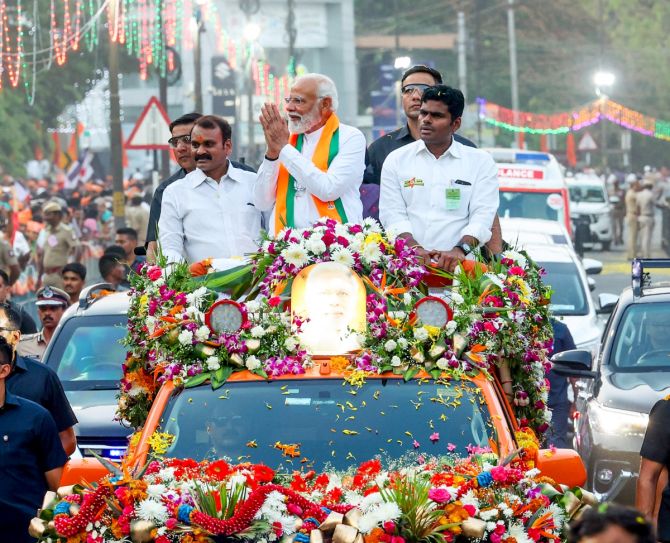
The odds, at the end of the day, are loaded in favour of the DMK-Congress combine.
The original logic that ‘arithmetic’ than voter chemistry and Annamalai’s dynamics worked in their favour, has returned to the centre-table, after months of politics and less than three weeks of campaign.
The DMK combine had polled a 53 per cent vote-share in 2019 and the rival AIADMK-BJP-PMK alliance, 33.
Indications are that the DMK combine will win more seats than the other two, but is facing a tough fight in about half a dozen from the rest, where the light and dust in this campaign period has clouded the vision of candidates, their managers — and also independent poll observers.
Granting that anti-incumbency against the Stalin government took away a substantial 10 to 15 per cent vote-share from the combine’s tally, a vertical split of sorts in the Opposition votes between the BJP-NDA and the AIADMK alliance, where late film star Vijayakanth’s DMDK is the sole recognisable ally, yet with no vote to call its own, is expected to help the DMK combine win most, if not all of the seats.
Vijayakanth’s son Vijaya Prabhakar is said to be giving tough competition to incumbent Congress MP Manickam Tagore, together purportedly pushing BJP’s Radhikaa Sarath Kumar, to the third slot. But elsewhere, BJP star candidates are in the limelight, but it is not as sure as the BJP’s prediction that Annamalai, Tamizhisai and Murugan would all win their respective seats.
National media analysts would only have to go back to their beat diaries from past elections in the state to recall how they had hailed Tamizhisai and Murugan as unstoppable state party bosses the same way they have been promoting Annamalai now.
That makes them three-some though in that order, Murugan, despite his Vel Yatra, carrying the traditional weapon of Lord Muruga, defying the Covid lock-out, tried to do a one-up on Tamizhisai, who was bereft of antics of the kind but was still shrill, yet, loud, in talking dime a dozen on all things politics, both national and regional — as and when newsmen approached her with a microphone, which was almost always as with Annamalai now. But she was not abusive at any time — and that’s the difference.
PS: Guess, what is the outcome of the heated poll campaign in the summer that commenced early across the state and has become scorching and unbearable from the very start in late-March? No one, politicians and voters alike, is talking about the skyrocketing gold price, which used to be a standard yardstick to measure the middle class mood, especially of women.
If it’s going to influence the voter, it will go against the BJP ruling the Centre, like most other issues pertaining to price rise and inflation.
Then, of course, there is the outside chance of a lower turn-out than the 70-plus per cent mark from elections in the past two decades, owing to the summer heat, absence of ‘exciting election issues’, and perceived poor ‘supply’ of money, owing to competitive raids by central and state agencies.
If in the past, a ‘token system’ for cash and gifts was introduced in the state, now there is open talk of ‘delivery’ post-poll. Maybe, also for this reason, the Election Commission has extended the ‘model code’ period, until the June 4 vote-count.
N Sathiya Moorthy, veteran journalist and author, is a Chennai-based policy analyst and political commentator.
The article appeared in Rediff.com
